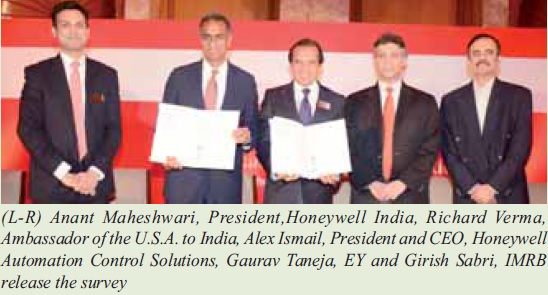A survey of 2,000 buildings across India by Honeywell and research-specialist IMRB International shows that government, building owners and service providers need to invest more in smart building technologies to better serve India’s rapidly urbanizing population and help create sustainable cities and infrastructure. While the country’s airports and hotels are leading the way with smart building technologies, the survey found that in general the smartness of buildings in India is low. The survey marks the debut of Honeywell Smart Building ScoreTM, a global tool that evaluates buildings based on each facility’s use of technologies to make the building green, safe, and productive – three key aspects of smart buildings. The Honeywell
Smart Building ScoreTM evaluates a building’s use of 15 technology asset groups that make a building green, safe, and productive, based on the systems’ overall capability, coverage of the facility, and uptime. The survey findings were accompanied by a white paper from Honeywell and Ernst and Young, ‘Smart Buildings Make Smart Cities,’ which details how targeted investment in smart buildings can be used to drive economic and environmental benefits, protect human life and building assets, and support India’s goal to develop 100 Smart Cities. Honeywell leaders presented the findings at an event including government dignitaries and public policy experts, building owners, architects, and building consultants. The 2,000 buildings participating in the survey covered 10 key building verticals: airports, hotels, hospitals, private offices, retail, surface transport, government offices, education and social spaces, public services, and residential. The buildings are located in Ahmedabad, Bangalore, Chennai, Delhi-NCR, Hyderabad, Kolkata, Mumbai, and Pune.
Among the key findings of the survey are:
• In general, the smartness of buildings in India is low. On a scale of 1 to 100, the national average Honeywell Smart Building ScoreTM for these buildings is only 33.
• Airports and hotels in India have the smartest buildings overall (average Smart Building Scores of 49 and 41, respectively).
• Scoring the lowest were buildings in the education (27) and residential (26) categories.
• Most buildings in the survey score highest on green elements (45), potentially reflecting the focus on sustainability from leading global and Indian rating agencies, as well as government incentives to improve building sustainability and energy efficiency.
• Safety scores of buildings on average were very low at 21, highlighting potential risks and the need for greater investments in safety and security solutions.
• The lowest rated aspect of buildings in the survey was the safety and personal protection of workers who service and maintain these buildings, at 8.
• Both private (34) and public (29) buildings have similar overall scores, indicating opportunities and needs exist for both sectors.
• Bangalore has invested the most in smart buildings (57%), potentially owing to newer construction, while Mumbai can do more (36%). These percentages denote asset capability only, and not asset coverage, or asset uptime.
• The survey points out significant differences between topand low-scoring verticals. For example, while airports score 55 in safety, the education and social spaces as well as the residential verticals score 14. Similarly, public services, which include police stations, fire stations, courts, passport offices, post offices, and prisons, have a safety score of only 18.
Honeywell employs close to 13,000 people across 50 locations including Delhi, Pune, Bangalore, Hyderabad, Chennai, Gurgaon, Vadodara and Madurai.
For additional information on Honeywell India, please visit http://honeywell.com/country/in/
Disclaimer: The information provided within this publication / eBook/ content is for general informational purposes only. While we try to keep the information up-to-date and correct, there are no representations or warranties, express or implied, about the completeness, accuracy, reliability, suitability or availability with respect to the information, products, services, or related graphics contained in this publication / eBook/ content for any purpose. Any use of this information is at your own risk.
 Youth
Youth
 Women
Women
 Research for Ishrae
Research for Ishrae







